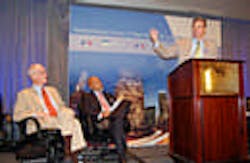WASHINGTON D.C. Painting U.S. surface transportation networks as broken and failing, riddled with inefficient funding mechanisms and "perverse incentives," a bipartisan think tank is urging a total overhaul of U.S. transportation policy.
Calling its recommendations a "framework for comprehensive reform," the Bipartisan Policy Center's National Transportation Policy Project (NTPP) proposes major changes, including restructuring federal transportation programs and reducing their total number from 108 to just six; updating the criteria for formulas; and creating a performance-based system that directly ties transportation spending to broader national goals, including economic growth, connectivity, accessibility, safety, energy security and environmental protection.
"Our current [surface] transportation system is strained to capacity and congested; its infrastructure is aging and delinquent; there is little accountability for funding; and there is no recognition of the policy link between transportation and economic growth, energy security and the environment," said former Congressman Sherwood "Sherry" Boehlert, one the report's four co-chairs, at a press conference in the nation's capital this week.
Read entire Transportation reform blueprint released article.
WASHINGTON D.C. Painting U.S. surface transportation networks as broken and failing, riddled with inefficient funding mechanisms and "perverse incentives," a bipartisan think tank is urging a total overhaul of U.S. transportation policy.
Calling its recommendations a "framework for comprehensive reform," the Bipartisan Policy Center's National Transportation Policy Project (NTPP) proposes major changes, including restructuring federal transportation programs and reducing their total number from 108 to just six; updating the criteria for formulas; and creating a performance-based system that directly ties transportation spending to broader national goals, including economic growth, connectivity, accessibility, safety, energy security and environmental protection.
"Our current [surface] transportation system is strained to capacity and congested; its infrastructure is aging and delinquent; there is little accountability for funding; and there is no recognition of the policy link between transportation and economic growth, energy security and the environment," said former Congressman Sherwood "Sherry" Boehlert, one the report's four co-chairs, at a press conference in the nation's capital this week.
"One of the principal current problems is trying to coordinate over 100 different transportation programs that Congress has authorized over the course of half a century, while dealing with an aging and a declining infrastructure," added fellow co-chair and former Sen. Slade Gorton.
Boehlert also stressed change of this magnitude won't occur overnight. "It took nearly a half century to lose our focus on national transportation policy," he said. "It will take time to get it back."
Freight movement also plays a huge role in this new report -- entitled "Performance Driven: A New Vision for U.S. Transportation Policy." It calls for a more "multimodal" approach to the shipment of goods across America.
"Truckers do a great job moving freight and railroads do a great job moving freight," noted NTPP co-chair and former Detroit Mayor Dennis Archer. "But what matters is what is in the best interest of the economy as a whole. It may be surprising to learn that we do not currently have a specific national freight policy -- and we need one to help us recognize the importance of freight in the modern era."
Sen. Mark Warner (D-VA) -- a former NTPP co-chair -- stressed that achieving such a massive overhaul and redirection of U.S. transportation policy is going to require a major bipartisan effort.
"We need a framework on the policy side -- and this is not just for the highway bill; this is for all U.S. transportation policies," he said. "We must take a very bipartisan approach to the funding and structure of transportation in this country; it's an approach Congress desperately needs, because we need to recognize the old ways [for funding transportation] don't work in the 21st century."
That means moving to "mode neutral" formula programs that award federal transportation dollars based on system condition and performance and focus on preserving the overall system, according to the NTPP's report.
At the same time, a new system of metrics would measure project performance in several areas: improved access, a more efficient national network, reduced corridor congestion and petroleum consumption, reduced CO2 [carbon dioxide] emissions, and reduced fatalities and injuries. States and regions whose investments performed well against those goals would be entitled to bonus funding; areas that did not would be subject to greater federal scrutiny in receiving transportation funding, the report said.
"This idea, called mode-neutrality, enables states … to make their own decisions about how to spend federal money as long as their investments meet accountability standards and promote national goals," Warner said.
Yet many of the NTPP's proposals in its report are not without controversy. Former Congressman Martin Sabo alluded to that when discussing the need for new and expanded sources of transportation funding.
"Clearly, our transportation system needs more funds to run it and, clearly, not all of it can come from fuel taxes," he said. "It's a mistake to fund transportation from general revenue sources. We must use fees and we need to start putting in place a VMT [vehicle miles travelled] fee for the future."
While not a popular idea in many corners, Sabo noted such fees would help Americans stop taking transportation for granted. "We need to give transportation systems users a true idea of the cost of transportation in the U.S.," he said. "And the way we raise such revenue must also be tied in to help us meet our transportation goals in terms of reducing energy consumption and protecting the environment."
About the Author
Sean Kilcarr
Editor in Chief
Sean Kilcarr is a former longtime FleetOwner senior editor who wrote for the publication from 2000 to 2018. He served as editor-in-chief from 2017 to 2018.
